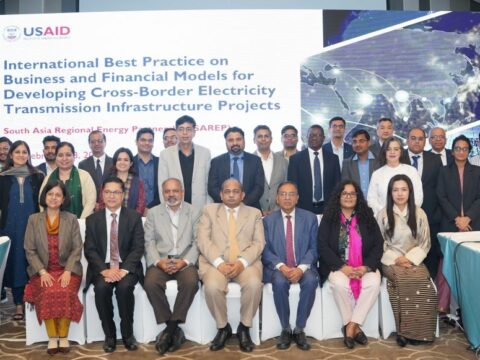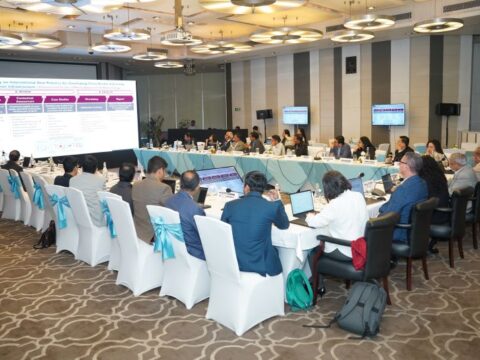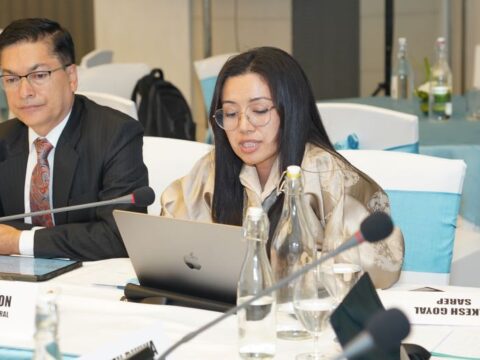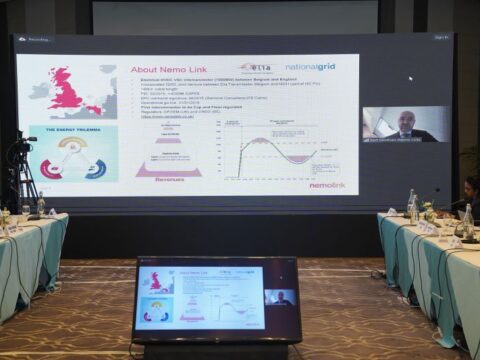Workshop on International Best Practice on Business and Financial Models for Developing Cross-Border Electricity Transmission Infrastructure
South Asia (SA) Countries (SACs) are uniquely placed to achieve their clean energy transformation goals. The region has tremendous hydro potential (~350 GW) and significant solar (>1000 GW) and wind (1289 GW) energy potential. While SA is endowed with large (> 350 gigawatts) hydropower potential, only around 20 percent has been exploited so far. Without a regional resource development approach, most of these renewable energy resources will remain unutilised. The development of hydropower, a sustainable form of energy in the region would increase by 2.7 times over the next two decades if the region could facilitate an unconstrained flow of electricity across the borders in South Asia. CBET is gaining momentum with a greater number of cross-border power projects & transmission interconnections being planned and proposed, in particular in Bhutan, Bangladesh, India, Nepal, and Sri Lanka sub-region, which will enable greater integration of power systems of SA countries.
It is essential to have robust and adequate cross border transmission interconnection in South Asia to realise the benefit of regional energy resources. Development of cross border transmission interconnections are complex due to various technological, financial, and business model related factors, including the additional risk due to its cross-border element. It is observed that cross-border transmission interconnections take long time to come into existence starting from their conception stage. Around the globe various business and financial models have been adopted to develop Cross-Border Electricity Transmission Infrastructure. Region should create conducive business and financial models which shall help in creating an ecosystem where transmission infrastructure including cross border interconnection, have to be developed ahead of power generation. Cross-border electricity transmission infrastructure provides potential benefits for participating nations, such as increased access to renewable energy resources, improved energy security, economic benefits, provide market access, and improved grid stability.
Adequate cross border transmission infrastructure is required between two countries for import / export requirement as well as augmentation in the National Grid for absorption / onward transfer of Power.
In the above context, to support and aid the development of Cross-Border Electricity Transmission, USAID through South Asia Regional Energy Partnership (SAREP) program commissioned a detailed study on the international best practice on business and financial models including investment entities, ownership, financing mechanism, project structuring, risk management, allocation principles, and cost recovery methods for developing cross-border electricity transmission infrastructure projects.
Rationale of the Study: Considering that multiple cross border electricity transmission lines are under planning and/or construction phase in the South Asia region, a consolidated study report based on International Best Practice on the available options for business model, project structuring, cost sharing, benefit sharing, risk allocation etc. with respect to which may facilitate faster decision making among regional participants and help in investment mobilization of cross border transmission interconnection in South Asia and also help in trans-regional interconnection is being worked upon under OSOWOG.
Considering the multi stakeholder perspective associated with Cross-border electricity transmission infrastructure development and larger OSOWOG objective, the stakeholder consultation workshop on “International best practices on business and financial models for cross border transmission infrastructure projects” was held on 28th Feb 24 at Le Meridien in New Delhi. The consultation workshop was organized to discuss and deliberate and seek feedback on the interim findings of the USAID-SAREP’s study findings on “International best practice on business and financial models for developing cross-border electricity transmission infrastructure project” and deliberate on some key international best practices from international experts and practitioners.
The workshop brought together experts from Central America, Europe, Africa, and Gulf along with key stakeholders from South Asia to share insights/perspectives and feedback on the key findings of the report. The workshop was attended by ~30 in person participants including 5 international speakers from Central America, Zimbabwe, Bhutan, and Nepal, and 35 virtual participants. Some of key participating organisation were:- Central Electricity Authority (CEA), India, South African Power Pool (SAPP), GCC Interconnection Authority (GCCIA), Empresa Proprietaria de la Red – EPR (which owns SIEPAC (Central American Electrical Interconnection System, Spanish: Sistema de Interconexión Eléctrica de los Países de América Central), NEMO Link, Power Grid Company of Bangladesh, Ministry of Energy and Natural Resources, Bhutan, ERA , Bhutan, BPC, Bhutan, PGCIL India, CTU India Limited, Grid Controller of India Limited, BSPTCL, SJVN Limited, Adani Energy Solutions Ltd, Sterlite Power, , Pancheswor Development Authority, Nepal, Rastriya Prasaran Grid Company Limited, Nepal, ERC, Nepal, Ceylon Electricity Board, Sri Lanka, MIGA World Bank and International Solar Alliance.
The sessions in the consultation workshop deliberated on South Asian regional context of cross border transmission interconnections, scope of work, methodology, approach and key findings of the interim report on International best practice on business and financial models for developing cross-border electricity transmission infrastructure project, experiences of developing cross border transmission in Southern African Power Pool, Central American Electrical Interconnection System (SIEPAC), Gulf Cooperation Council (GCC) Interconnection, Nemo Link interconnector, development of cross border interconnection for facilitating energy transition, One Sun One World One Grid (OSOWOG) initiative and experiences of policy makers, regulators, transmission system planners , major transmission utilities (both public and private sector) from of each south Asian countries.
The deliberation in the workshop were very rich and interesting. Discussion was focused on business models, financing options, revenue / tariff mechanisms, and institutional structures relating to the development of cross border electricity transmission infrastructure. Some interesting and innovative highlights/take away from discussion are as follows.
Establishing a robust institutional framework and dedicated funding pool/facilities are vital for seamless implementation of cross-border interconnections. Regional Transmission Infrastructure Financing (RTIFF) in SAAP is such an example. Engaging the private sector through innovative financing models like joint ventures (JVs) or concessions can accelerate infrastructure development, provided the regulatory environment supports fair competitive bidding and stable payment security mechanisms.
Development of regional power market and granting liberal access to regional power markets can expedite development by encouraging market participation. Regional cooperation in financing is pivotal, with financial support for multi-country projects overcoming investment barriers and promoting sustainable development. Developing regional planning can also help faster and optimal development of cross border transmission system.
Most of the regional electricity markets, in Europe and the South Africa region, follow a regional planning approach that includes regional transmission plan. SAREP’s Task Force-2 on “Advancement of Transmission System Interconnections” for Cross Border Electricity Trade (CBET) is looking to develop BBINS Long term perspective South Asia Regional Electricity Generation and Transmission Plan up to the year 2040 including identification of transmission capacity and cross border system interconnection options for regional cross border trading along with funding/investment models for cross border Transmission Infrastructure. This plan will provide a long-term outlook for transmission system integration by adopting a regional approach to planning, which will optimize transmission infrastructure requirements and ensure that economical network integration takes place while maintaining satisfactory system reliability and security. SAREP is also working to create “South Asia Network for Integrated Power System Planning and Operation (SANIPO)“, a regional level platform to facilitate capacity building, knowledge exchange and sharing of best practices related to Integrated Power System Planning and Operation.
Inter-governmental and inter-utility MOUs have helped some regions globally to take forward multi-country cross border transmission interconnections like the Central American Electricity Market Framework Treaty or the Marco Treaty.
Enabling Power Market frameworks and regulatory frameworks globally are driving the feasibility of cross border transmission interconnectors – some examples include the cap-and-floor regulated tariff which has been agreed by the regulators in UK and Belgium for the NEMO link, and the revenues that are assured through market mechanisms such as auctioning of transmission rights, use of capacity markets and ancillary services market.
Workshop discussed many interesting business models including an evolved version of the cross-border transmission interconnection company such as EPR from SEIPAC not being an SPV but a private registered entity in Central America operating through regional markets and institutional framework.
Investment decisions are driven by assured revenue for the interconnect – some examples of anchor customers (MOZAL)/ generators like seen in the case of MOTRACO model (The Mozambique Transmission Company (MOTRACO), was set up as an SPV to own and operate the Mozambique – Eswatini – South Africa trilateral cross border transmission lines) have worked very well in drawing financing of such projects.
Elucidated very clearly in the case of SIEPAC , how regional markets and regional institutions can play a critical role in development and in optimizing regional cross border transmission interconnections and roles that are played by regional institutions i.e., CDMER, CRIE, EOR, EPR.
By embracing multidirectional approaches, countries can foster greater collaboration and efficiency in developing and operating cross-border transmission infrastructure.
In conclusion, the consultation workshop represents a significant step towards achieving resilient and sustainable cross-border electricity transmission infrastructure in South Asia. By leveraging international best practices and fostering regional cooperation, countries can overcome challenges and realize the benefits of integrated energy systems, ultimately contributing to a more secure and prosperous future for the region.
As a next step, SAREP shall incorporate the valuable inputs and suggestions made during the workshop and finalise the report which shall be released through a dissemination workshop.
Agenda:
Interim Report:
Presentation:
- Presentation on Study on International Best Practice for Developing Cross Border Electricity Transmission Infrastructure by Rajiv Ratna Panda, PMS, SAREP
- Presentation on Key Findings of the interim report Study on international best practice for developing CB transmission infrastructure by Arun K A, Deloitte
- Presentation on Southern African Experiences in Cross Border Electricity Transmission Projects by Stephen Dihwa, ED, SAPP Coordination Centre, SAPP
- Presentation on Electrical Integration in Central America by Karla Hernandez and Martin, EPR, SIEPAC
- Presentation on Business model for cross border electricity transmission lines in GCC region by Eng. Ikram Rahim, GCCIA
- Presentation on Nemolink updates on Cap and Floor interconnector by Bart Goethals, Chief Commercial Officer, NEMO Link
- Presentation on Development of Cross Border Interconnection Facilitating Energy Transition by Shri Ashok Pal, Deputy COO, CTU India





































